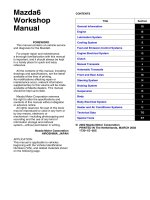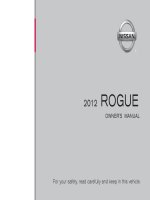Toyota RAV4 2012 workshop manual
Bạn đang xem bản rút gọn của tài liệu. Xem và tải ngay bản đầy đủ của tài liệu tại đây (31.18 MB, 576 trang )
RAV4 EV
2 0 1 2
Quick RefeRence Guide
VeV
Downloaded from www.Manualslib.com manuals search engine
2012
RAV4 EV
This Quick Reference Guide is a summary of basic vehicle operations.
It contains brief descriptions of fundamental operations so you can
locate and use the vehicle’s main equipment quickly and easily.
The Quick Reference Guide is not intended as a substitute for the
Owner’s Manual located in the vehicle’s glove box. We strongly
encourage you to review the Owner’s Manual and supplementary
manuals so you will have a better understanding of the vehicle’s
capabilities and limitations.
Your dealership and the entire staff of Toyota Motor Sales, U.S.A.,
Inc. wish you many years of satisfied driving in your new RAV4 EV.
A word about safe vehicle operations
This Quick Reference Guide is not a full description of RAV4 EV
operations. Every RAV4 EV owner should review the Owner’s
Manual that accompanies this vehicle.
Pay special attention to the boxed information highlighted in
color throughout the Owner’s Manual. Each box contains safe
operating instructions to help you avoid injury or equipment
malfunction.
All information in this Quick Reference Guide is current at the
time of printing. Toyota reserves the right to make changes at
any time without notice.
Downloaded from www.Manualslib.com manuals search engine
INDEX
IN
Charge port
Hood release
Indicator symbols
Instrument cluster
Instrument panel
Keyless entry*
Motor maintenance
Smart Key system*
8
8
4-5
4
2-3
6
9
7
ELECTRIC VEHICLE SYSTEM
19-24
14-17
18
12
13
28
10
25-26
29
27-28
11
OV
FEA
ELECTRIC VEHICLE SYSTEM
Charging
Charging cable-Plugging in
Charging cable-Unplugging
Charging equipment
Charging-Power sources
Confirming charge settings
Electric Vehicle System
Extended charge mode
Inspecting electrical leakage
detection function
Multi-Information
Display-Charging information
Range Map screen
Air Conditioning/Heating
37
Clock
38
Cruise control
41
Door locks
35
Hill-start Assist Control (HAC)
43
40
iPod®/USB/AUX port
Light control-Instrument panel
35
Lights & turn signals
33
Multi-Information Display
42
Navigation system
38-39
Parking brake
30
Power outlets-12V DC
42
Seat adjustments-Front
31
Seat adjustments-Rear
31
Seat heaters
37
Seats-Folding down rear seats
32
Seats-Head restraints
32
Steering wheel switches
40
Telephone controls (Bluetooth®)
36
Tilt and telescopic steering wheel 41
Transmission
30
VSC OFF button
43
Windows-Power
34
Windshield wipers & washers
34
OVERVIEW
FEATURES/OPERATIONS
OVERVIEW
SAFETY AND EMERGENCY FEATURES
Downloaded from www.Manualslib.com manuals search engine
1
SAF
EM
SAFETY AND EMERGENCY FEATURES
* Visit your Toyota dealer for information on customizing this feature.
FEATURES/OPERATIONS
Doors-Child safety locks
44
Emergency tire puncture repair kit 45
Floor mat installation
47
Seat belts
44
Seat belts-Shoulder belt anchor
45
TM
46-47
Star Safety System
Tire Pressure Monitoring
45
(warning) System
OVERVIEW
Instrument panel
Steering wheel controls
Steering wheel audio controls
Telephone controls
Multi-Information Display switch
Speech command button
Cruise control
Headlight and turn signal control
Wiper and washer controls
Emergency flasher switch
Navigation/Audio system*
Power button
Immobilizer indicator
Clock and HVAC display
Front passenger occupant classification indicator
Air Conditioning controls
Seat heater controls
Downloaded from www.Manualslib.com manuals search engine
2
Re
12
SP
VS
Til
Ma
Ins
*F
OVERVIEW
ELECTRIC VEHICLE SYSTEM
Downloaded from www.Manualslib.com manuals search engine
3
SAFETY AND EMERGENCY FEATURES
* For details, refer to the “Navigation System Owner’s Manual.”
FEATURES/OPERATIONS
Rear window and outside rearview mirror defogger switch
12V DC Power outlet
SPORT mode switch
VSC OFF switch
Tilt and telescopic steering release
Manual headlight leveling dial
Instrument panel light control
OVERVIEW
Instrument cluster
EV System indicator
SOC (State Of Charge) gauge
Driving range
Service indicator and reminder
Speedometer
Multi-Information Display
Transmission shift position indicator
Odometer and two trip meters
Display change button
Indicator symbols
Brake system warning (red)1
Brake system warning (yellow)1
Driver/Front passenger seat belt reminder
(alarm will sound if speed is over 12 mph)
12-volt battery charging system warning1
Plug-in indicator (yellow/green)
Output control warning
SOC (state of charge) warning
Master warning
Open door warning
1
If indicator does not turn off within a few seconds of starting EV System, there may be a
malfunction. Have vehicle inspected by your Toyota dealer.
Downloaded from www.Manualslib.com manuals search engine
4
2
If thi
OVERVIEW
SRS Airbag warning1
Low Tire Pressure Warning1
Electric power steering system warning1
Front passenger occupant classification indicator
Headlight low/high beam indicator
Turn signal indicator
Transmission shift position indicator
Slip indicator/Hill-start Assist Control (HAC) indicator1
Cruise control indicator2/Cruise control SET indicator2
Anti-lock Brake System warning1
ELECTRIC VEHICLE SYSTEM
Vehicle Stability Control (VSC) OFF indicator1
Traction Control OFF indicator1
SPORT mode indicator
Immobilizer indicator
FEATURES/OPERATIONS
ECO Driving Indicator Light1
READY indicator
Charging indicator
If this light flashes, refer to “Cruise control,” Section 2-4, 2012 Owner’s Manual.
Downloaded from www.Manualslib.com manuals search engine
5
SAFETY AND EMERGENCY FEATURES
2
OVERVIEW
Keyless entry
Sma
Beep sound can be switched ON or OFF. Refer to the Owner’s Manual for more
details.
Start
Locking operation
C
Push
NOTE
Pow
Unlocking operation
Witho
opera
ACC
ON
Push ONCE: Driver door
TWICE: All doors
NOTE: If a door is not opened within 60 seconds of unlocking, all doors will relock for
OFF
Lock
safety.
Panic button
Carry
Push and hold
Back
Carry
to loc
* Driv
all d
NOTE
Downloaded from www.Manualslib.com manuals search engine
6
e
OVERVIEW
Smart Key system
Start function
Green indicator ON
Depress
brake pedal
Carrying
Push
Power (without starting EV System)
Without depressing the brake pedal, pressing the “POWER” switch will change the
operation mode in succession from:
ACCESSORY Accessories such as the radio will operate.
ON
OFF
for
ELECTRIC VEHICLE SYSTEM
NOTE: Shift position must be in Park and brake pedal depressed.
Power ON; the EV System is not engaged.
All systems OFF.
Locking operation
Unlocking operation
Grasp
Push
Carry remote to lock
FEATURES/OPERATIONS
Front door unlock*
Front door lock
Carry remote to unlock
Back door lock/unlock
Push
Grasp
* Driver door unlocking function can be programmed to unlock driver door only, or
all doors. Grasping passenger door handle or back door opener will unlock all doors.
NOTE: Doors may also be locked/unlocked using remote.
Downloaded from www.Manualslib.com manuals search engine
7
SAFETY AND EMERGENCY FEATURES
Carry remote
to lock/unlock
OVERVIEW
Mot
Charge port
Driver seat
Unlock
Open
Pull up
Hood release
Pull up latch
and raise hood
Pull
Mo
He
Tr
Wi
NOTE
Engage support rod
Lift up support rod
Downloaded from www.Manualslib.com manuals search engine
8
OVERVIEW
Motor maintenance
ELECTRIC VEHICLE SYSTEM
Motor coolant reservoir
Heater coolant reservoir
Traction battery coolant reservoir
Windshield and back window washer fluid tank
FEATURES/OPERATIONS
NOTE: Regularly scheduled maintenance will help extend the life of your
vehicle and maintain performance. Please refer to the “Warranty
Maintenance Guide.”
SAFETY AND EMERGENCY FEATURES
Downloaded from www.Manualslib.com manuals search engine
9
ELECTRIC VEHICLE SYSTEM
Electric Vehicle System
Ran
The RAV4 EV uses electricity in a rechargeable traction battery to power the
electric motor. The driving range is extended by using regenerative braking to
store electricity in the traction battery. This technology is clean and has a low
impact on the environment by not emitting exhaust such as CO2 or NOX during
operation.
The d
refere
Refer
Tips for reducing battery consumption
-Keep the EV System indicator needle within the ECO area.
-Drive in normal mode.
-When possible, avoid driving on steep inclines.
-Avoid driving at speeds that are higher than necessary, especially on the highway.
-When possible, avoid sudden stops to maximize regenerative braking energy.
-Minimize use of Air Conditioning and heating; the seat heater may also be used to
supplement heating.
-Maintain recommended tire pressure and avoid carrying unnecessary luggage.
-Utilize the Pre-climate function to warm or cool cabin before driving.
Starting the EV System
(1) Depress the brake pedal, and
press the “POWER” switch
while in Park.
(2) After a few seconds the
“READY” light comes on and a
beep sounds.
Downloaded from www.Manualslib.com manuals search engine
10
Ch
Ra
Re
Cu
Zo
Dis
Dis
Zo
Cli
The driving area possible on the current charge level can be displayed as a
reference, as can charge stations in the surrounding area.
w
Refer to the Owner’s Manual for more details.
ed to
FEATURES/OPERATIONS
Charge station
Range circle
Reachable destination guidance
Current position
Zoom out button
Display round trip driving range
Display one-way driving range
Zoom in button
Climate setting
ELECTRIC VEHICLE SYSTEM
(1) Press “HOME” button.
(2) Touch “EV” followed
by “Range Map” on the
screen to display the
range map screen.
way.
a
OVERVIEW
Range Map screen
SAFETY AND EMERGENCY FEATURES
Downloaded from www.Manualslib.com manuals search engine
11
ELECTRIC VEHICLE SYSTEM
Cha
Charging equipment
A Lev
charg
time
for m
-Conn
5-15R
curre
-Toyo
recep
-For p
J177
statio
-When
that
Charging
Charging
Charging
Charging
Charging
NOTE
cable
port door
port cap
port
indicator
The charging cable included with the vehicle is designed to be connected only
to an AC 120V power source.
Charging connector
Latch release button
CCID (Charging Circuit Interrupting Device)
Plug
Power indicator
Error warning indicator
Test button
Reset button
Downloaded from www.Manualslib.com manuals search engine
12
See th
A Level 1 charging cable is provided with your RAV4 EV. However, a Level 2 (240V)
charging station is strongly recommended. Level 2 charging offers a faster charge
time than AC 120V charging. Please contact your Authorized Toyota RAV4 EV Dealer
for more information on obtaining a Level 2 charging station for your home.
OVERVIEW
Charging-Power sources
-Connect your Level 1 charging cable to an AC 120V electrical receptacle (NEMA
5-15R or NEMA 5-20R) with a Ground-Fault Circuit-Interrupter (GFCI) and an over
current circuit breaker in the service panel.
-Toyota recommends using a dedicated receptacle with a single socket. If the
receptacle has two sockets, do not plug any other item into the other socket.
-When charging outdoors, be sure to connect to a rain tight electrical receptacle
that is appropriate for outdoor use.
NOTE: Do not attempt to use a damaged or loose electrical receptacle to
charge your vehicle.
ELECTRIC VEHICLE SYSTEM
-For public charging, this vehicle may only be charged at stations that are SAE
J1772 compliant. Use your navigation system to search for nearby public charging
stations.
Do not connect the charging
cable to a multi-outlet adapter,
multi-plugs, or conversion plug.
ly
See the Owner’s Manual for important precautionary information.
Downloaded from www.Manualslib.com manuals search engine
13
SAFETY AND EMERGENCY FEATURES
Do not connect to a power strip.
FEATURES/OPERATIONS
Do not connect the charging cable
to an extension cable. The cable
may overheat and does not contain
a Ground-Fault Circuit-Interrupter
(GFCI).
ELECTRIC VEHICLE SYSTEM
Step
Charging cable-Plugging in
Step 1 Plug the charging cable into the electrical receptacle of the external
power source.
“While-in-use”
cover
- Ensure that the standards of the
electrical receptacle and the
charging cable’s plug match.
- Check that the power indicator
of the CCID (Charging Circuit
Interrupting Device) is illuminated.
- Hanging the CCID on a hook is
recommended to reduce the strain
on the electrical receptacle and
charging cable plug.
Step
- When charging outdoors, use a
“while-in-use” cover.
Step 2 Press the test button on the CCID to check that the electrical leakage
detection function operates properly.
- If the error warning indicator
illuminates when test button is
pressed, the function is operating
correctly.
- After the test is completed, press
reset button to turn off the error
warning. Charging cannot occur
while error warning is illuminated.
- If the error warning indicator does
not come on when test button is
pressed, the function may not be
operating correctly. Stop charging
immediately and contact your
Toyota dealer.
Downloaded from www.Manualslib.com manuals search engine
14
Step
OVERVIEW
Step 3 Pull up the charging port door lever.
d.
Step 4 Open the charging port cap by releasing the clip.
Push to
open
g
ELECTRIC VEHICLE SYSTEM
in
Step 5 Remove the charging connector cap. Affix the cap to the cable.
FEATURES/OPERATIONS
s
r
d.
es
e
g
SAFETY AND EMERGENCY FEATURES
Downloaded from www.Manualslib.com manuals search engine
15
ELECTRIC VEHICLE SYSTEM
Step 6 Insert the charging cable connector into the charging port.
- Do not press the latch release button
when inserting the connector.
- Align with the guide position shown
on underside of the charging
connector, and push it in straight
and firmly until it clicks. Confirm
connector is securely locked.
- The plug-in indicator on the meter
illuminates in green if correctly
plugged in. Incorrect plug-in results
in a yellow plug-in indicator.
- If no schedule is set, or the charge
immediately function is selected,
charging will begin by simply
plugging in the charging cable.
- If EV System is on when the vehicle
is plugged in, the READY indicator
will turn off and a message will show
in the Multi-Information Display.
Step 7 Check the status of the charging indicator.
Light A
Downloaded from www.Manualslib.com manuals search engine
16
Light B
The c
illumi
Char
vehic
Pre-c
Char
Char
less
Char
Malfu
charg
The in
conne
time
navig
wn
t
m
er
ge
,
cle
r
how
Light A
Light B
Charging cable is connected to
vehicle and the charging and/or
Pre-climate schedule is set
Lights A and B flash on and off alternatively
for 10 minutes (after 10 minutes, lights
remain off until charging starts).
Charge level is less than 49%
Flashes
Off
Charge level is between 50% and
less than 99%
Illuminates
Flashes
Charging is complete
Both lights A and B illuminate for 10 minutes
(after 10 minutes, both lights turn off).
Malfunction occurred during
charging
Both lights A and B quickly flash
simultaneously for 10 seconds (after 10
seconds both lights turn off).
The indicator lights will not flash or turn on if the charging cable is not
connected properly. During charging, current charging status and the estimated
time until charge completion can be checked on the Multi-Information Display or
navigation display.
ELECTRIC VEHICLE SYSTEM
ults
Charging indicator
Charging status
OVERVIEW
tton
The charging indicator consists of two lights that display charging status by
illuminating, flashing and turning off as follows:
FEATURES/OPERATIONS
SAFETY AND EMERGENCY FEATURES
Downloaded from www.Manualslib.com manuals search engine
17
ELECTRIC VEHICLE SYSTEM
Charging cable-Unplugging
Cha
Step 1 Pull the charging connector toward you while pressing the latch release
button.
If the charging connector is
disconnected during charging (while
the charging indicator indicates the
vehicle is being charged), charging
will be interrupted.
Depen
plugg
Pre-c
recom
-Park
-All w
-Engin
-All li
When
Pre-c
secon
Step 2 Attach the charging connector cap.
By M
Step 3 Close the charging port cap, and then close the charging port door.
Firmly push the charging port cap
and charging port door, and check
that they are securely locked.
Char
Step 4 Remove the plug from the electrical receptacle when the charging
equipment will not be used for a long period of time.
- Hold the body of the plug while
removing.
- Make sure to put the cable away
immediately after disconnecting.
- When leaving the plug inserted, check
the plug and connector once a month
for accumulation of dirt or dust.
Downloaded from www.Manualslib.com manuals search engine
18
Ne
Ba
Ch
Ch
Ne
De
Ex
e
Depending on the charge settings, the vehicle may not start charging just by
plugging in the charging cable. Use the navigation screen to set the charging and
Pre-climate/remote climate control schedules. Before either function starts, it is
recommended that:
e
e
-Parking brake is securely set with shift position in “P”
-All windows and doors are closed
-Engine hood is securely closed
-All lights are turned off
By My Departure schedule setting
FEATURES/OPERATIONS
Charge and Pre-climate schedule setting screen
Downloaded from www.Manualslib.com manuals search engine
19
SAFETY AND EMERGENCY FEATURES
heck
onth
Set departure time dial
Charge Only button
Pre-climate Only button
Charge and Pre-climate button
Add/Delete button
Next charge start schedule
Battery charge amount
Charge complete schedule
Charge immediately button
Next departure schedule
Departure schedule Edit button
Extended charge mode setting button
ELECTRIC VEHICLE SYSTEM
When the EV System is turned off, the screen changes to the charging and
Pre-climate settings screen. If no operations are performed for approximately 30
seconds, the screen turns off.
OVERVIEW
Charging
ELECTRIC VEHICLE SYSTEM
Pre-climate (Remote Climate Control)
Adjusting cabin temperature before driving reduces traction battery consumption
after departure, thereby increasing driving range. If the amount of charge
remaining in the traction battery is less than 50% at the time Pre-climate
operation is scheduled to begin, Pre-climate operations will not be performed in
order to preserve driving range.
The climate control system can be turned on before entering the vehicle by
setting the Pre-climate schedule or using the Smartphone Entune® EV Remote
Climate application on a smartphone.
Pre-climate operations completion can be set for a specific time on each day of
the week.
Char
Depen
charg
This s
Start
Step
Step
Charging settings
The RAV4 EV may be charged immediately, or scheduled to charge at a specific
time each day.
System
Details
Charge immediately Starts charging immediately
regardless of charging schedule settings.
Scheduled charging Charge completion can be set
for a specific time on each day of the week. If no
schedule is set, the system defaults to the Charge
Immediately function.
Charging
Step
Prese
Step
Step
Step
Entune®
Smartphone
EV Applications
Drivers with a smartphone and active Entune® and Safety Connect® subscriptions
may remotely interact with several features of the RAV4 EV.
For details, please refer to or call
1-800-331-4331.
Step
Imme
Step
about
Step
Downloaded from www.Manualslib.com manuals search engine
20
in
Depending on the charge settings, the vehicle may not automatically start
charging upon plug-in. You may set it to Charge Immediately in one of two ways.
This setting will temporarily override any schedule that may already be set.
OVERVIEW
ion
Charge Immediately
Start Charge Immediately
Step 1 Turn the EV System off. The charge settings screen will be displayed. If no
actions are performed, screen will turn off after 30 seconds.
of
Step 2 Touch “Charge Immediately.”
c
Step 3 Plug in the charging cable. Charging will start.
ELECTRIC VEHICLE SYSTEM
After operations have been
completed, the “Charge
Immediately” screen button
indicator illuminates.
Preset Charge Immediately
Step 1 Touch EV on the Main Menu.
Step 2 Touch “Charging & Pre-climate Setup.”
to display the “Charge Immediately on Plug-in” screen.
Step 3 Touch
Touch “Save.”
FEATURES/OPERATIONS
ns
Step 4 A screen advising that charge mode has been changed to Charge
Immediately is displayed. The EV screen returns after a few seconds.
Step 6 Plug in the charging cable. Charging will start.
Downloaded from www.Manualslib.com manuals search engine
21
SAFETY AND EMERGENCY FEATURES
Step 5 Turn the EV System off. The charge settings screen will be displayed for
about 30 seconds.
ELECTRIC VEHICLE SYSTEM
Scheduled charging
Step
Charging and Pre-climate operations may be programmed to complete at a specific
time on any or all days of the week.
If “Ke
EV sc
for ad
Set charging/Pre-climate schedule
Step 1 Touch EV.
Step 2 Touch “Charging & Pre-climate Setup.”
to display the “My Departure Schedule” screen. Touch
Step 3 Touch
“Schedule Setup.”
Step 4 Touch desired day.
Step
A scre
return
Step 5 Flick the schedule to the desired time for charging and/or Pre-climate
completion. Select Charge Only, Pre-climate Only or Charge & Pre-climate.
- Up to three actions can be set for a
single day by touching “Add.”
- To delete the set action, touch
“Delete.”
- Two actions cannot be set at the
same time.
Step 6 After settings have been completed, touch
My Departure Schedule.”
twice to return to the “By
Step 7 Touch “Save.” If “Save” is not touched, the changes will not be reflected
in the charging schedule.
Downloaded from www.Manualslib.com manuals search engine
22
ecific
If “Keep My Schedule” is touched, setting the charging schedule is done and the
EV screen returns. Touch “Return to Schedule Setup” to set the charging schedule
for additional days.
A screen advising that settings have been completed appears. The EV screen
returns after a few seconds.
ELECTRIC VEHICLE SYSTEM
Step 9 When charging schedule is set for each day of the week:
OVERVIEW
Step 8 When charging schedule is only set for some days of the week:
mate.
ra
FEATURES/OPERATIONS
“By
SAFETY AND EMERGENCY FEATURES
ted
Downloaded from www.Manualslib.com manuals search engine
23









